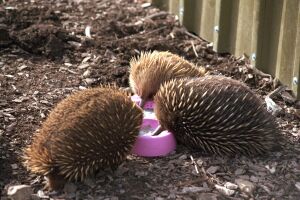
The echidna is one of only two species of the Monotremata order. Egg laying mammals. The other being the Platypus. Having many skeletal like features of reptiles and laying leathery shelled eggs also like a reptile, the echidna has both fur and spines and is warm blooded and feed their young on milk. The echidna is distributed throughout Australia. The echidna is easily recognizable by its long spines with a coarse fur between these spines. It has a specialized mouth, 'beak' or snout with no teeth and a long sticky tongue with which it licks up ants and termites which are its sole source of food. It can dig and break up ants nests and termite mounds with the aid of its strong snout and very strong front paws. It is a solitary animal with an overlapping home range, it does not have a fixed nesting site by shelters under or in hollow logs, thick bushes or burrows. The female mates in July to August and lays a small soft shelled egg about two weeks after mating. The egg is placed in a soft 'pouch' in the belly of the female and hatches in about ten days. The young remains in the pouch for three months feeding on milk exuded from numerous pores from the two mammary glands. By the time the young leave the pouch it is covered in short spines. Like the platypus, the male echidna has a spur on the ankle of its hind legs but unlike the platypus it does not have a venom gland. When disturbed the echidna can role up into a spiny ball (like a hedgehog) or dig down rapidly into the ground remaining horizontal and showing its spiny surface or by extending its spines can wedge itself in a hollow log or crevice.
